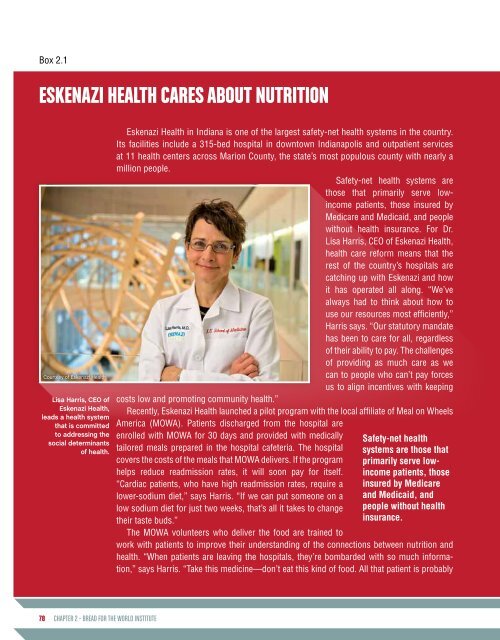THE NOURISHING EFFECT
HR2016-Full-Report-Web
HR2016-Full-Report-Web
Create successful ePaper yourself
Turn your PDF publications into a flip-book with our unique Google optimized e-Paper software.
Box 2.1<br />
ESKENAZI HEALTH CARES ABOUT NUTRITION<br />
Courtesy of Eskenazi Health<br />
Lisa Harris, CEO of<br />
Eskenazi Health,<br />
leads a health system<br />
that is committed<br />
to addressing the<br />
social determinants<br />
of health.<br />
Eskenazi Health in Indiana is one of the largest safety-net health systems in the country.<br />
Its facilities include a 315-bed hospital in downtown Indianapolis and outpatient services<br />
at 11 health centers across Marion County, the state’s most populous county with nearly a<br />
million people.<br />
Safety-net health systems are<br />
those that primarily serve lowincome<br />
patients, those insured by<br />
Medicare and Medicaid, and people<br />
without health insurance. For Dr.<br />
Lisa Harris, CEO of Eskenazi Health,<br />
health care reform means that the<br />
rest of the country’s hospitals are<br />
catching up with Eskenazi and how<br />
it has operated all along. “We’ve<br />
always had to think about how to<br />
use our resources most efficiently,”<br />
Harris says. “Our statutory mandate<br />
has been to care for all, regardless<br />
of their ability to pay. The challenges<br />
of providing as much care as we<br />
can to people who can’t pay forces<br />
us to align incentives with keeping<br />
costs low and promoting community health.”<br />
Recently, Eskenazi Health launched a pilot program with the local affiliate of Meal on Wheels<br />
America (MOWA). Patients discharged from the hospital are<br />
enrolled with MOWA for 30 days and provided with medically<br />
tailored meals prepared in the hospital cafeteria. The hospital<br />
covers the costs of the meals that MOWA delivers. If the program<br />
helps reduce readmission rates, it will soon pay for itself.<br />
“Cardiac patients, who have high readmission rates, require a<br />
lower-sodium diet,” says Harris. “If we can put someone on a<br />
low sodium diet for just two weeks, that’s all it takes to change<br />
their taste buds.”<br />
The MOWA volunteers who deliver the food are trained to<br />
Safety-net health<br />
systems are those that<br />
primarily serve lowincome<br />
patients, those<br />
insured by Medicare<br />
and Medicaid, and<br />
people without health<br />
insurance.<br />
work with patients to improve their understanding of the connections between nutrition and<br />
health. “When patients are leaving the hospitals, they’re bombarded with so much information,”<br />
says Harris. “Take this medicine—don’t eat this kind of food. All that patient is probably<br />
78 CHAPTER 2 • BREAD FOR <strong>THE</strong> WORLD INSTITUTE


